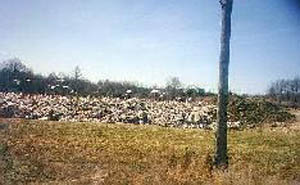Global Warming's Latest Culprit - the City Dump
By Marti Matsch
May 24, 2002


The Kersey Valley Landfill in High Point, North Carolina. Built in an established residential area in 1993, the landfills boundaries lie within 57 feet of the water wells of some residents. The landfill was supposed to bring jobs. It also brought buzzards, rats, noise, visual blight and the inevitable order of methane gas. To learn more about how the residents have been fighting back, visit the following website: http://thedumpsite.homestead.com/buffer. |
According to the Union of Concerned Scientists, human-induced global warming is underway right now -- and the evidence shows that landfills are a major contributor to these ominous climatic changes. Carbon dioxide produced during fossil fuel (including waste incinerator) combustion is the main culprit in global warming, but methane also plays a very important role. And the number-one source of human-caused methane emissions is buried waste.
Methane is a potent greenhouse gas, 21 times more effective at trapping radiant heat than carbon dioxide. This potency means that landfills contribute 10% of the gases that are warming the globe. Even worse, when landfilling, incineration, and the extractive industries are all taken together, our wasteful nature-to-landfill system accounts for fully 25% of our society's greenhouse gas emissions.
Methane is produced in a landfill when the organic materials like paper, yard debris, wood, and food waste undergo anaerobic decomposition. This process shouldn't be confused with the aerobic process that breaks downs the fruit rinds and leaves in your backyard composter. As a result of anaerobic decomposition, the methane gas seeps to the surface, enters the lower atmosphere, and in concert with carbon dioxide and other gases creates a warming blanket that retains solar infrared radiation and warms the earth.
Many landfills use gas capture systems to control emissions. But according to the US Environmental Protection Agency (which currently subsidizes gas capture efforts through their Landfill Methane Outreach Program), these systems are only partially effective, capturing just 20-25% of total methane emissions. In addition, gas capture subsidies -- and other federal subsidies to the landfill and incineration industries -- can serve to prompt the further burying of resources. Why not feed the landfill if it is a good source of usable gas? Well, one good reason is that the gas produced by landfills includes toluene, benzene and other toxic fumes. These could be avoided altogether if more cities and states prohibited the landfilling of organics in the first place.
The current waste industry response to the landfill gas problem is to champion so-called "bioreactor" landfills. In contradiction to the "dry tomb" landfill philosophy of the early 1990's, water is intentionally pumped INTO bioreactor landfills to accelerate the decomposition of organics and speed production of methane gas. But bioreactor landfills are fraught with technical problems. Most importantly, there is no controlling the chemical reactions that result when organic material interacts with the hazardous waste in the landfill. Also, the energy captured from landfill gases is much less than the energy saved by composting or recycling. This is yet another reason to keep organics out of the landfill in the first place.
By eliminating the organics that we send to the landfill through better source prevention, recycling and composting programs, we can limit our landfill methane problem. Legislation is one part of the solution. In Norway, for example, some of the environmental costs of landfills are accounted for by a law that requires landfills to charge no less than $100 per ton for burying waste. Here in the US, the state of Wisconsin has implemented a ban on landfilling yard waste, corrugated cardboard, newspaper, and magazines -- all organic materials. In Colorado, we lag behind Wisconsin and many other states. With some of the lowest landfill fees in the nation (just $15/ton, on average) and no legislation banning materials from the landfill, Coloradoans have the go-ahead for burying recoverable resources like paper and toxic materials like electronic equipment and batteries.
The phenomenon of human-induced climate change is a complex one, and eliminating the contribution made by US landfills alone won't solve the problem. Still, by taking a Zero Waste approach we can focus on addressing the concerns that worsen the landfill crisis. This approach includes: changing wasteful product and packaging design; creating reuse, recycling and composting infrastructure; reducing product and packaging toxicity; accounting for the real environmental damages involved in making goods from virgin resources; and ending subsidies for the wasting industries.
By keeping organics out of the landfill and supporting Zero Waste enterprises, we can reduce the impact these materials have on the rate of global climate change. And that's good for us, our children, and the planet.
For more information contact:
Reprinted with the permission of the good people at EcoCycle Times [PO Box 19006, Bourlder, CO 80308, (303) 444-6634]. You can check them out at www.ecocycle.org.







